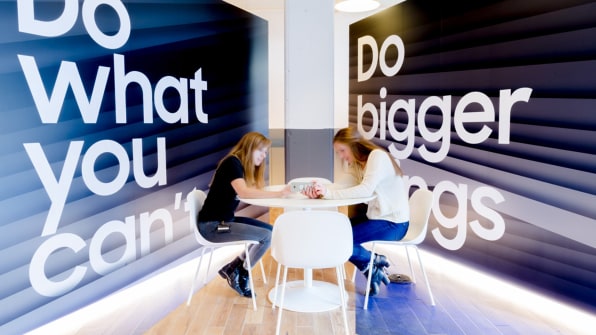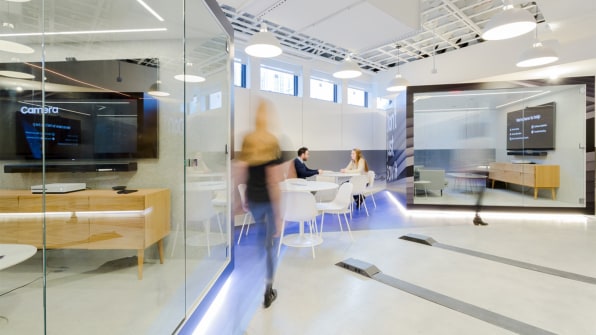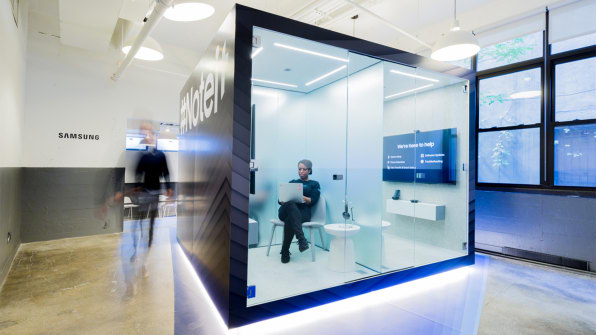The once-revolutionary Genius Bar now sorta stinks–and Samsung thinks it can do better.
Mick McConnell was sitting with his wife at one of Apple’s Genius Bars when he realized the charm of the experience had worn thin. After an hour and a half of waiting past his appointment, the sterile frozen yogurt shop vibe had finally lost its chill.
“I was like, there’s gotta be a better way to do this,” McConnell recounts. It’s a sentiment many of us share, especially those of us who have waited for our turn at an Apple Store on a busy weekend. But in McConnell’s case, he was in the position to do something about it. As the VP of design at Samsung Electronics America, he realized that there was an opportunity for his own company to outdo the Genius Bar.

So this month, Samsung is partnering with the coworking startup WeWorkto try a quietly radical new approach to customer service. Samsung is opening three pilot service centers, which it dubs “care centers,” in WeWork locations in Detroit, Miami, and Williamsburg, New York. The idea is this: Any Samsung customer can go to get help with any of their products at a care center. But while they wait, they’re not just pacing around a store. They can actually take full advantage of the WeWork space, getting work done while drinking fresh coffee or fruit-infused water.“Service is a hassle. I know I’m going to have to take time out of my day to do it,” says McConnell. “The concept was, if I take time out of my day, at least I can sit in a conference room, make phone calls, and do work, as opposed to sitting in a busy room with a bunch of angry people.”

Of course, Samsung didn’t just set up a Genius Bar in the corner. It’s actually taking over a small chunk of each WeWork in an attempt to make it an even more premium space to get work done. The centerpiece is a Miesian black steel and glass box–what the team has cheekily dubbed an internet cafe–with shared tables and Samsung workstations. The rest of the space features a midcentury-inspired design that’s along the lines of what you see at many WeWorks, but areas like phone booths have been enhanced with higher-end furnishings and Samsung video conferencing systems rather than mere phones.“Some of these spaces are truly WeWork spaces on steroids,” says Danny Orenstein, founder of Turnkey & Bespoke and project director of Samsung Retail Design. The hope is not only to make Samsung’s own customers feel welcome in the WeWork space, but to make WeWork subscribers feel comfortable working in the Samsung space, too–presumably so that WeWork’s young, creative class will warm to the technology brand.
Samsung’s relationship with WeWork actually goes back a year, and the companies have learned from their early mistakes. In one installation in Austin, Samsung had set up special VR chairs and tablet stations at a WeWork to showcase its hardware–but this was more a marketing tactic than a considered experience. “Everyone tried the VR chair once or twice, and then it became a thing that was in the way in the lounge, or it disrupted their meeting space,” says McConnell. Now, Samsung wants to be a real partner. The company will even be hosting a series of after-hours talks with creatives in WeWork spaces. In theory, if WeWork’s customers like Samsung, Samsung gets new customers. And if Samsung’s customers like WeWork, WeWork gets more new subscribers. That’s the sort of brand synergy that could ultimately benefit both companies. Samsung declined to share any financial arrangements about the deal, but it is sponsoring the buildout of its premium spaces.

It’s important to remember that this is still an experiment, and Samsung intends to learn before expanding the program. Problems as simple as onboarding–how do you get a person with a broken phone, who has never visited a WeWork before, through the lobby to get the help they need–still need to be solved. And if Samsung is successful at attracting the masses, how does it ensure WeWork’s exclusive atmosphere doesn’t become an open season mall? So for now, Samsung customers will only be able to get what’s called “tier 1” support at these centers. That means they can get informed, technical help as to how to use their phone, and the staff can even take a piece of equipment and mail it away to be fixed. But tier 2 support–which would include replacing a screen or hard drive on site–hasn’t been implemented yet.That said, if these WeWork Care centers are well received, it could be big. There are 235 WeWork locations (a number that is growing) into which Samsung could potentially scale in the future, which is about half the headcount of Apple’s roughly 500 stores but significant all the same. And while we’d all agree that the Genius Bar was truly revolutionary in 2001, the fact of the matter is that stores aren’t pleasant town squares, and nobody wants to wait to get their laptop fixed when they could be working.
–
This article first appeared in www.fastcodesign.com
Seeking to build and grow your brand using the force of consumer insight, strategic foresight, creative disruption and technology prowess? Talk to us at +9714 3867728 or mail: info@groupisd.com or visit www.groupisd.com

